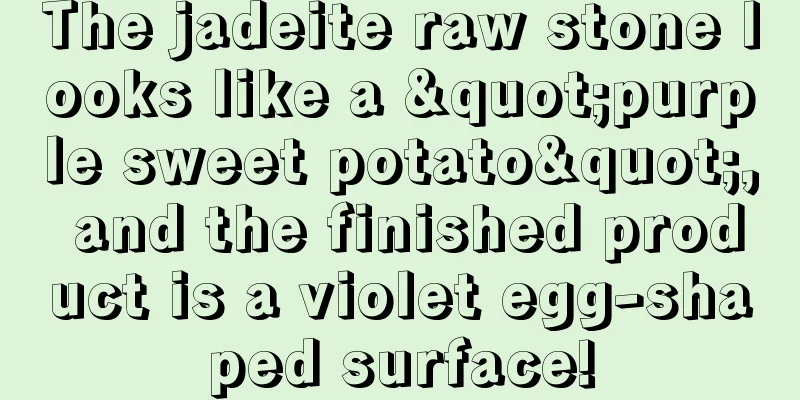The most reliable method to identify jadeite! Surprisingly simple

|
How to identify the authenticity of jade This is a rather complicated question to answer. I will explain step by step~ 1. Common imitations of jadeite and their identification 2. Identification of A\B\C jadeite 3. New fraud methods 4. Jade quality assessment 1. Common imitations of jadeite and their identification 1. Sodium feldspar jade (also known as "water foam") It has good water content, and some even have blue flowers. It is mostly used to imitate ice and glass jadeite. It is also easy to identify, has no brittleness (commonly known as fly wings), and feels lighter than jadeite. 2. Quartz jade, such as Miyu, Guicui, Aventurine, Jingbaiyu, etc., have the same characteristic that their internal structure is granular and has no jadeite properties. 3. Chrysoprase Cryptocrystalline, the internal structure cannot be seen (Note: the internal structure of jade is a typical fiber interwoven structure) In addition, there are hydrogrossular garnet, green glass, Dushan jade, etc., which are all sold as A-grade goods by unscrupulous merchants in the more mixed markets. The identification methods are very abstract. If you have any questions, you can find a local jewelry and jade quality inspection station and test it. It only takes five minutes, which is much faster than researching it online. This is the most reliable way to identify jadeite. When purchasing, look for the authoritative certificate and pay attention to whether the photo, weight, etc. on the certificate are consistent with the product. If necessary, you can confirm it on the official website. 2. Identification of A\B\C jadeite A-grade jade refers to natural jadeite; B-grade jade is jade that has been chemically bleached and then filled with resin; C-grade jade is jade that has been dyed. What is most common on the market now are B+C goods, which are made by combining B goods and C goods simultaneously, and are soaked in strong acid for filling and dyeing. The identification method is to observe whether there is the acid-etched mesh pattern that is characteristic of B-grade jadeite. This is due to the corrosive effect of strong acid, which makes the gaps between jadeite mineral particles very obvious, like spider-web-like cracks, which are called "acid etching lines". Secondly, observe the color distribution of the jadeite. The green color of B-grade jadeite is like fog. After acid washing, the tightness of the internal structure of the jadeite will be destroyed, so the original color will be dispersed and the color root of the jadeite cannot be found. Colored roots Foggy color 3. New fraud methods that need attention Image from Shenzhen Laboratory of National Inspection Center When the pendant is illuminated from the side, a bright circle can be clearly seen around the jade egg-shaped surface. This kind of color-matching jadeite is made by gluing colorless jadeite pieces with good water quality onto inferior jadeite, green glass or green jade pieces coated with green dye, and then camouflaging the bonding areas. In short, the devil is always one step ahead of the saint. The safest way to determine the authenticity of jadeite is to send it to a quality inspection agency for testing with professional instruments. 4. Jade quality assessment The reason why we have to add this paragraph is that A-grade jade does not represent good and expensive jade. There are a lot of A-grade jadeite on Taobao that costs only a dozen yuan. Most of them are indeed A-grade, but the quality is really... The jadeite that is worth tens of millions at auctions is also A-grade. The evaluation principles of jadeite are: color, clarity, cut, crack, 2T: transparency, texture, 1V: volume. None of these factors can be missing. 1. The color should be bright, rich and uniform. 2. Transparency and structure In the industry, the comprehensive performance of jade's transparency and structure is usually referred to as "type" or "ground". For example, glass type, ice type, glutinous rice type, bean type, etc. 3. Carving evaluation (Cut): outline, symmetry, proportion, curvature, thickness, color, etc. 4. Clarity Finally, check whether there are factors that affect the clarity, such as stone flowers, cracks, etc.
feicuibbs feicuibbs9 |
<<: Optimization of Jade and Identification of True and Fake Jade
>>: Jade identification skills, 4 tricks to easily identify the authenticity of jade
Recommend
Why do people like to carve bat patterns on jadeite? What is the special meaning behind it?
Every time bats are mentioned, everyone is very s...
The process of carving a piece of jadeite into a finished product!
Today, let's take a look at the carving proce...
What kind of jade can be considered to have good craftsmanship?
When buying jade, many people pay more attention ...
How do jade carving masters carve jade?
Looking at the dazzling array of beautiful jewelr...
The master used the leftover high-quality ice jadeite from a friend's cutting to create an ancient tooth with his ingenious idea!
After the jadeite raw stone is cut and the finish...
How to choose a jade ring? It’s not difficult, grasping these points is the key!
Jade rings are simple and elegant, with both the ...
The craftsmanship of hand-carved jadeite
A piece of jade rough material needs to go throug...
What does the lotus in jade carvings mean?
There is an old saying in the jade industry that ...
Ordinary jade is too boring? ! Black jade is killing it
Black is a color that is difficult to define with...
Jade, it turns out that it can be so beautiful!
It is a high-end jewelry representing the East. I...
Good jade underground is rarer than a big house on the ground!
Life is like a journey. When you set out on a jou...
To choose a good jadeite, 5 words are enough
No matter how long you have been in the jade circ...
When choosing jadeite, is it better to have a plain surface or one with carvings?
As we all know, the beauty of jade lies in its qu...
Good jade is not so easy to carve out, you think it is too simple!
When we walk into some jade shops every day, we c...
What does A-grade jadeite mean? How to tell whether jade is A grade?
We all know that the value of jade has always bee...









